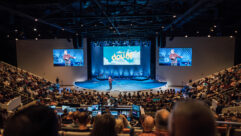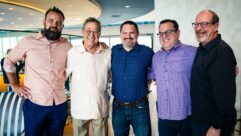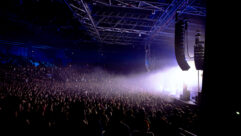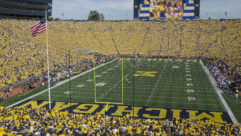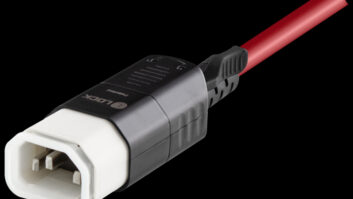ARE you EXPERIENCED?
Nov 1, 2000 12:00 PM,
Mel Lambert
Seattle’s Experience Music Project illustrates science and art in close harmony.
It is no exaggeration to state that the Experience Music Project (EMP) is a unique environment. EMP was conceived by co-founders Paul G. Allen and Jody Allen Patton, his sister. Located in downtown Seattle, EMP, which opened on June 23, 2000, combines a number of interactive and interpretive exhibits with an extensive collection of memorabilia housed in an imaginative building designed by architect Frank O. Gehry. Gehry’s other works include the Guggenheim Museum in Bilbao, Spain, and the Fredrick R. Weisman Art Museum, Minneapolis, MN.
Allen said that EMP is dedicated to capturing and reflecting the essence of rock and roll and places a strong emphasis on high-quality sound and accompanying visuals, both static and moving, inviting visitors to participate in a total sensory experience. EMP’s permanent collection includes musical instruments, a large recorded sound archive, film, photographs and handwritten song lyrics.
The 140,000 ft squard (13,000 m squard) building houses a number of interactive exhibits that allow visitors to create their own music, see and learn about rare memorabilia from the museum’s collection, explore musical milestones within unique interpretive exhibits and enjoy music in all its forms. Originally, so the story goes, the project started life as a modest, 10,000 ft squard (930 m squard) floor museum dedicated to the memory of Seattle alumni Jimi Hendrix. Reported costs of the final complex are in the region of $250 million, including $140 million for installed equipment.
Paul Zumwalt, director of design and construction with Vulcan Northwest (Allen’s development company) said, “We have been working on EMP since 1996. Once we had received a floor plan from Frank Gehry and input from the other eight members of our interior design team, we began to develop an overview of the various audio and video environments required to complement the theme of this unique building. To ensure that our visitors enjoy the exhibits, we have stretched the envelope in terms of state-of-the-art sound and video design.”
Design concernsThe interconnected space is divided into a number of performance and interactive areas. The largest is Sky Church, a spacious, high-ceilinged assembly arena with a gigantic videowall onto which are displayed live-performance movies, concert videos and related media. Other areas within EMP include Guitar Gallery (a collection of milestone instruments); Hendrix Gallery (a homage to the city-born guitar genius), Artist’s Journey (a multimedia theme ride), JBL Theater (for special events and concerts), Learning Lab and Compaq Digital Lab, Milestones (an A-V history of modern music), Sound Lab (where visitors can play musical instruments and experience music-making first hand), and On Stage (where visitors participate in a live concert environment).
In terms of sound equipment, Zumwalt acknowledged that the delivery of high-quality sound in such a complex environment is an acoustics nightmare. Many spaces are finished in raw concrete, and there are large amounts of glass, polished steel and other reflective surface to consider. Zumwalt said that the key was the use of absorbent material to contain the sound and structural isolation to prevent low frequencies, in particular, from traveling among discrete environments.
To ensure sonic consistency and deal with a single vendor EMP selected Harman International and its component brands to supply the majority of sound equipment. Coordinated by the Harman Professional Projects Group (HPPG), providing large project factory support service for Harman Professional product lines, the museum development team was provided with a single point of contact. JBL Professional, for example, was selected as exclusive provider of loudspeakers throughout the entire facility, including live performance and interactive museum areas. The 200-seat JBL Theatre includes a JBL Professional ScreenArray cinema sound playback system and is used for live performance, seminars and screenings of in-house EMP productions. Other applications include the utilization of stock product lines, modified stock products and the creation of entirely new products using JBL drivers augmented with custom crossover networks and DSPs.
“The foundation of all the speaker systems throughout the project,” said Rod Falconer, HPPG marketing manager, “is the gene pool of JBL drivers we are able to draw from. These proven components allowed us to specifically tailor each system to its individual requirements. The systems include high-level live performance and playback systems, unusual applications for stock products like the LE8T-H and ScreenArray systems, weather-resistant treatments of stock speakers for outdoor use, and complete custom loudspeaker systems like the line-arrays. We wanted the performance of each system to reflect the legacy of JBL within the music industry, as well as what we are capable of today.”
“JBL is one of the EMP sponsors and partners,” Zumwalt said. “JBL provided all of the loudspeaker cabinets we specified for the facility and, in many cases, worked to customize audio treatments. One of the key aspects for the entire building is adaptability. We found JBL staff to be helpful in designing a flexible and adaptable sound system that will support everything from live music to background ambience, plus everything in between.”
Moreover, HPPG worked closely with contractors, designers and EMP staff to maximize the effectiveness of JBL loudspeakers and other Harman products, according to Zumwalt. Amps from Crown, Allen & Heath and JBL were used throughout the site, as were multiple BSS Soundweb audio-processing systems, dbx Technologies signal processing units and Soundcraft mixing consoles.
“EMP is a spectacular realization of an amazing vision,” said Ken Blecher, director of HPPG. “In all aspects of the design and execution, it was readily apparent that this venue is dedicated to providing the highest standards of performance. Given JBL Professional’s shared history with the birth and development of rock and roll and its commitment to quality and design, it is fitting that JBL loudspeaker systems form an integral part of the museum’s expression of that vision.”
Customization meets off-the-shelf unitsIn addition to selecting off-the-shelf components offered by Harman and its subsidiaries, EMP designers were also able to call upon the JBL Custom Shop, which developed customized systems to fit the specific requirements of certain exhibits. The Milestones area, for example, presents an A-V history of modern music. The JBL Custom Shop, under direction from Jaffe Holden Scarbrough, the project’s acoustics and noise control consultants, designed a number of long, rectangular boxes, open at the bottom. These devices contain the sound to an area where visitors are looking at the relevant exhibits. The playback dispersion falls off rapidly within a couple of feet, allowing the listener to hear the narration and music from that specific area. Each tube houses a JBL LE8T-H 8 inch (203 mm) full-range loudspeaker.
JBL Installation Range and Contractor Control series loudspeakers systems are also featured throughout EMP’s interactive museum areas. The eight personal recording studios located in Sound Lab are outfitted with JBL Professional LSR series monitor loudspeakers as well as JBL Control series speaker systems in other areas. Lexicon MPX-series digital processors provide programmable room acoustics.
Within the ticketing area and entrance lobby, a JBL Custom Shop line-array is installed above each large-format plasma-screen monitor. These units were originally intended to be mounted on the side of each display, but EMP made the aesthetic decision to mount the arrays horizontally. Given the system’s characteristics, it still provides coverage of the immediate area in front of each display.
Innovation also touched other areas of the site. The 146 distributed ceiling loudspeakers throughout the facility are high-performance LE8T-H full-range units. The Liquid Lounge and other areas bar used the CSP18, an 8 inch, two-way loudspeaker with a 1 inch (25.4 mm) exit compression driver, for program playback. Further, the interior of the JBL Theater, designed by Gehry, uses a behind-the-screen system of JBL ScreenArray Cinema System units with customized surround-sound loudspeakers derived from JBL Model 8330 loudspeakers hidden behind custom covers.
Robert Fitzsimmons, EMP’s director of technology, said, “Once we had determined what was needed at each exhibit area and the low-level programming required to supply the necessary audio-video systems, our Exhibit Team could design the replay systems. We felt that we did not need to reinvent the wheel when so much of this capability and functionality was already in place and available off-the-shelf from Harman and its various brands.
“Our cable infrastructure is based upon a network control, which provides signal distribution and computer control of technology-driven exhibits. While we are still refining that vision – some functions will be added and enhanced over the coming months – we realized that central storage of sound and video files and high-speed distribution via a number of channels was the only way to go.”
To that end, BSS Soundweb provides computer-controlled DSP on all exhibit and specialty-audio systems. Each of the equipment rooms is interconnected with QSC Rave units using Peak Audio’s CobraNet to provide high-speed delivery of sound to various exhibit areas via 100 Base-T Ethernet using single CAT-5 cable. An estimated 25,000 miles (40,200 km) of cabling is used throughout the complex.
Digitized audio originates in AES/EBU digital format from a number of ENCO hard disk servers. Video playback is handled from a centralized SeaChange International MediaCluster disk-based server capable of delivering 24 Mbps of digitized component video in ITR-U 601 and MPEG2 compressed formats. The server features a fully redundant RAID topology and handles all scheduled playback. A pair of Pesa Jaguar routers provides first-level switching of A-V sources to designated exhibit destinations. Real-time show control is provided from a Pacific Interactive PacificStream system triggered against timecode. A total of 128 stereo pairs of AES/EBU digital audio is distributed the facility on Ethernet,which leaves room for future expansion.
“Up to 72 discrete channels of audio and video can be distributed from a central playback area,” said Graham Usherwood, EMP’s facility technology manager. “The 14 servers can provide a total playback capacity of 48 hours of multichannel audio and video material.”
Soundweb also offers flexibility for creating application-specific playback systems. For example, setting up a secondary audio feed in an exhibit area with overall EQ and dynamics control would normally take half a day with conventional hardware. Technicians can now do that in less than an hour with Soundweb and its PC-based control of processing functions. Other areas within EMP are supplied via Peavey MediaMatrix or Level Control Systems SuperNova systems.
Sky ChurchOf the environments offered at EMP, Sky Church represents its creative centerpiece. Designed to offer a great deal of flexibility, the original idea stemmed from Jimi Hendrix’s desire for an environment in which “all kinds of people, regardless of age, background or interests, could come together to appreciate music.” The multi-channel sound system comprises both stock JBL Venue series and Custom Shop loudspeakers arranged at three levels on either side of the 40 ft tall (12 m) by 70 ft wide (21 m) Sony Jumbotron videowall, supplemented by JBL Custom Shop 99 inches high by 6 ft wide (2.5 m x 1.8 m) vertical line arrays situated between banks of video display components. Because the line-array systems were incorporated into the screen, EMP can address sound right from the screen or locate it at specific places.
The 24-channel sound system is controlled from an audio booth located high on the rear wall, where a Mackie Digital 8 Bus console links to a Level Control Systems SuperNova hard-disk playback and computer-controlled routing unit. A total of 17 BSS Soundweb 9088 DSP systems provide zone-specific processing. EMP wanted highly directional loudspeakers with a wide array distribution. The basic system is laid out in a nine-channel array – left, center, right across the videowall (supported by the custom line-arrays) and left- and right-side front and rear, and rear-left and right. JBL MPX600 and MPX1200 power amps feed six JBL triamplified Venue series VS-3215 cabinets (left and right of videowall and on the other primary trusses for 360ø floor-level playback). Additional multi-channel playback support is provided for mid- and upper level localization by a total of 18 JBL Custom Shop 12 inch (305 mm) two-way cabinets mounted on three tiers throughout the space. Subwoofer support is provided by four Venue series VS-125HS horn-loaded subwoofers and seven 4642A-GS direct radiators for a total of eight 15 inch (381 mm) and 14 18 inch (457 mm) drivers.
The Artist’s JourneyArtist’s Journey includes a motion platform ride in four distinct stages. A-V systems for this area were designed by Soundelux, which functioned as the design-build firm for both Sky Church and Artist’s Journey and installation contractor for the balance of the project. Various pre-ride areas are supplied with video screens and loudspeakers to explain background to the ride, which consists of special effects, theatrical lighting, IMAX-style 70 mm film, audio, video, computer graphics and full 3-D motion. A total of 40 visitors can be accommodated on the ride at the same time. Act I is a lounge with JBL Control 1 loudspeakers. Act II is a tall room with a series of ramps, and Act III is a ride with incredible sonic blasts from all directions around the screen. System components include JBL Venue series, Sound Power, Marquis series, Control series, Screen-Array and custom subwoofer systems. A rear-projector screen uses a BARCO 9300 Series III, while six BARCO 6300 projectors are used in Act II.
“Working from an architectural overview,” said Howard Schlieper, Soundelux project manager, “we acted as design engineers for the complex audio and video systems used in Artist’s Journey. Our biggest challenge was to provide totally convincing screen image coupled with surround-sound playback. We could not place loudspeakers behind the screen because it is non-perforated, but the array sounds convincing. EMP opted for a non-perforated screen as the best option because it needed to form a curved projection using a Stewart’s Torus compound curved screen.”
A series of AKAI DS-16 hard disk recorders provide real-time playback of 16 discrete audio tracks; this capacity may be expanded in the future to 24 or 32 using synchronized units. A Peavey MediaMatrix system controls assignment and processing for a total of 21 playback channels and drives Crown Macro-Tech power amps. Loudspeakers include five JBL playback systems above the 26 ft high by 40 ft wide (7.9 m x 12 m) wrap-around screen, five below, four overhead, two to the left, two to the right and two below the ride, plus subwoofers. Cabinets include JBL 4641A-GS, SP125S and SP128S subwoofers, Venue series VS-3215-6, EON 15P, Control 5 and Control 1 plus custom-designed MS-28HR boxes, ScreenArray components and CSP-118S subwoofers. Power amps include JBL MPC200, MPC300 and MPC600 and Crown Macro-Tech series.
“In addition to the variety loudspeakers that were flown everywhere to facilitate surround-sound playback,” said Falconer, “an unusual product application was the use of a number of JBL Screen-Array cinema products, modified for this installation by removing their subwoofer cabinets and creating a flying frame.”
“The Experience Music Project is a great accomplishment,” said Zumwalt. “We were not interested in technology for technology’s sake. The end result is an inspired, creative environment, where sound and pictures blend with the unique exhibits to create a totally enveloping experience.”
One of the most challenging aspects of the design was the delivery of broadcast-quality audio and video from a single, reliable playback source. The decision was made to use a digital video server manufactured by SeaChange International. Running on an NT-based MPEG-2 video server platform, 72 outputs of discrete 601 video streaming from 14 mainframes and 112 hard disk drives have resulted in what is presently known as the largest broadcast media cluster in the world. An additional audio-only server by ENCO delivers wave-encoded files as AES audio to areas that do not require video.
EMP’s in-house multimedia department creates the media content that is ultimately distributed throughout the museum. These clips are then MPEG-2 encoded and pushed via the network to our main SeaChange AV Server located in MEC-1065 (main equipment center). Files are stored in the Raid 5 redundant topology and selected for playback using an elaborate custom control system developed by Pacific Interactive. Pacific Interactive’s UI allows us to control fully what file is played to each destination throughout the museum. The UI enables us to create play lists so we can stack multiple files in a seamless manner or create a schedule of what files playback at any given time and location.
The video is spooled out and delivered by two different methods depending on the area being served. Exhibit video passes through MEC-1038 and various BECs (branch equipment centers) and floor boxes until it reaches a D/A converter located near the video display. Other, non-exhibit areas are delivered similarly with the exception that more source playback flexibility is required. Therefore, they are delivered via a 64-channel PESA Jaguar router in 1038. We can then select independent or multiple destinations of a single file or playlist, or we can select a different source such as DigiBeta, BetaSP, SVHS, DVD, satellite TV, DSS, CATV, laserdisc, character generator or test generator. Video sources originating as analog are converted to SDI prior to the Jaguar and then converted to Y/C or YUV prior to the device.
Audio distribution is more complex. CobraNet essentially allows us to replace the typical analog cable infrastructure with digital technologies using our existing Ethernet backbone. After leaving the servers, all exhibit audio enters the network via a bank of QSC’s Rave CobraNet transmitters located in MEC-1038.
The ambient audio system includes several feeds from ENCO, SeaChange and PESA that pass through MediaMatrix before entering CobraNet. All DSP for ambient audio is done inside MediaMatrix and all exhibit audio is direct into CobraNet.
Once on the network, 128 channels of audio can be peeled off anywhere network connectivity is available. Located in the BECs are the QSC Rave receivers that intercept the selected audio channels for all exhibit and ambient audio zones. Exhibit and MEG (MEG is a portable handheld electronic device) audio signals are then processed using BSS Soundweb prior to the exhibit amplifiers and MEG RF transmitters. Unlike exhibit audio, ambient audio is passed from a corresponding analog Rave receiver directly to the amps feeding the ambient audio zones. The end result is a truly enhanced visitor experience with the synthesis of sound and sight.


